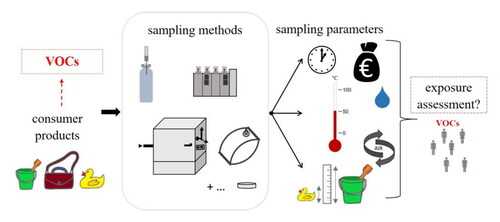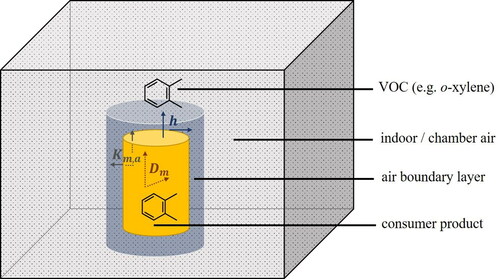Figures & data

Table 1. Physical parameters of selected volatile organic compounds (VOCs) in relation to their emissions from representative products, as encountered in indoor settings.
Figure 1. Physical processes involved in the emissions of volatile organic compounds (VOCs) from solid materials into indoor/test chamber air. VOC emissions are characterized by three main processes: internal diffusion (characterized by the diffusion coefficient, Dm), partitioning between the sample material surface and the surrounding air (characterized by the partition coefficient, Km,a) and external diffusion/convection (characterized by the convective mass transfer coefficient, h). The VOC depicted in this schematic is ortho-xylene.

Table 2. Comparison of sampling methods for VOC emissions from solid material consumer products, indicating their potentials and limitations.
Figure 2. Headspace and bag sampling methods covered in this review article for the analysis of volatile organic compound (VOC) emissions.

Figure 3. Overview of emission test chamber methods for the analysis of volatile organic compound (VOC) emissions.

Figure 4. Emissions of volatile organic compounds (VOCs) from polymer‐based consumer products: Comparison of three emission chamber sizes. Reproduced from Even et al.[Citation23] under public license (https://creativecommons.org/licenses/by/4.0/.).
![Figure 4. Emissions of volatile organic compounds (VOCs) from polymer‐based consumer products: Comparison of three emission chamber sizes. Reproduced from Even et al.[Citation23] under public license (https://creativecommons.org/licenses/by/4.0/.).](/cms/asset/5d9de773-448b-4bfb-9595-0c1582a89842/batc_a_2136484_f0004_b.jpg)